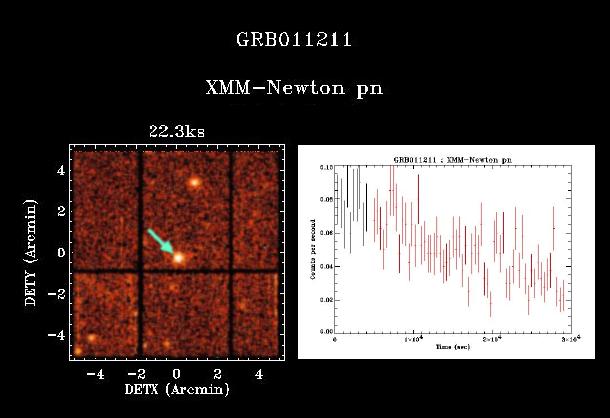
 Credit: XMM-Newton SOC; ESA
Credit: XMM-Newton SOC; ESA
Caught in the Act
Cosmic bursts of gamma-rays are some of the most elusive and mysterious
events in the Universe. Since gamma-rays are difficult to image, it remains
difficult to localize the bursts based on their gamma-ray emission. A
fruitful technique has been to localize the
burst using X-ray emission, since these bursts also produce X-ray
"afterglows", and since X-rays can be imaged with high precision. The above
image shows a gamma-ray burst observed by
the XMM-Newton X-ray telescope. The burst occurred on December 11, 2001
and was discovered by the BeppoSAX
high-energy satellite observatory; the XMM-Newton Science Operations Center
(SOC) was notified of the burst and quickly repointed the telescope to try
and catch the afterglow. The image on left shows the EPIC-PN observation of the bursting
source, marked by an arrow. The image on the right shows the variation of
the X-ray brightness of the source as seen by XMM-Newton (the black and red
points, respectively, represent the emission before and after the pointing
of the satellite was fine-tuned). The X-ray brightness of the source
decreased by about a factor of 2-3 through the XMM-Newton observation.
Last Week *
HEA Dictionary * Archive
* Search HEAPOW
* Education
Each week the HEASARC
brings you new, exciting and beautiful images from X-ray and Gamma ray
astronomy. Check back each week and be sure to check out the HEAPOW archive!
Page Author: Dr. Michael F.
Corcoran
Last modified April 4, 2002


